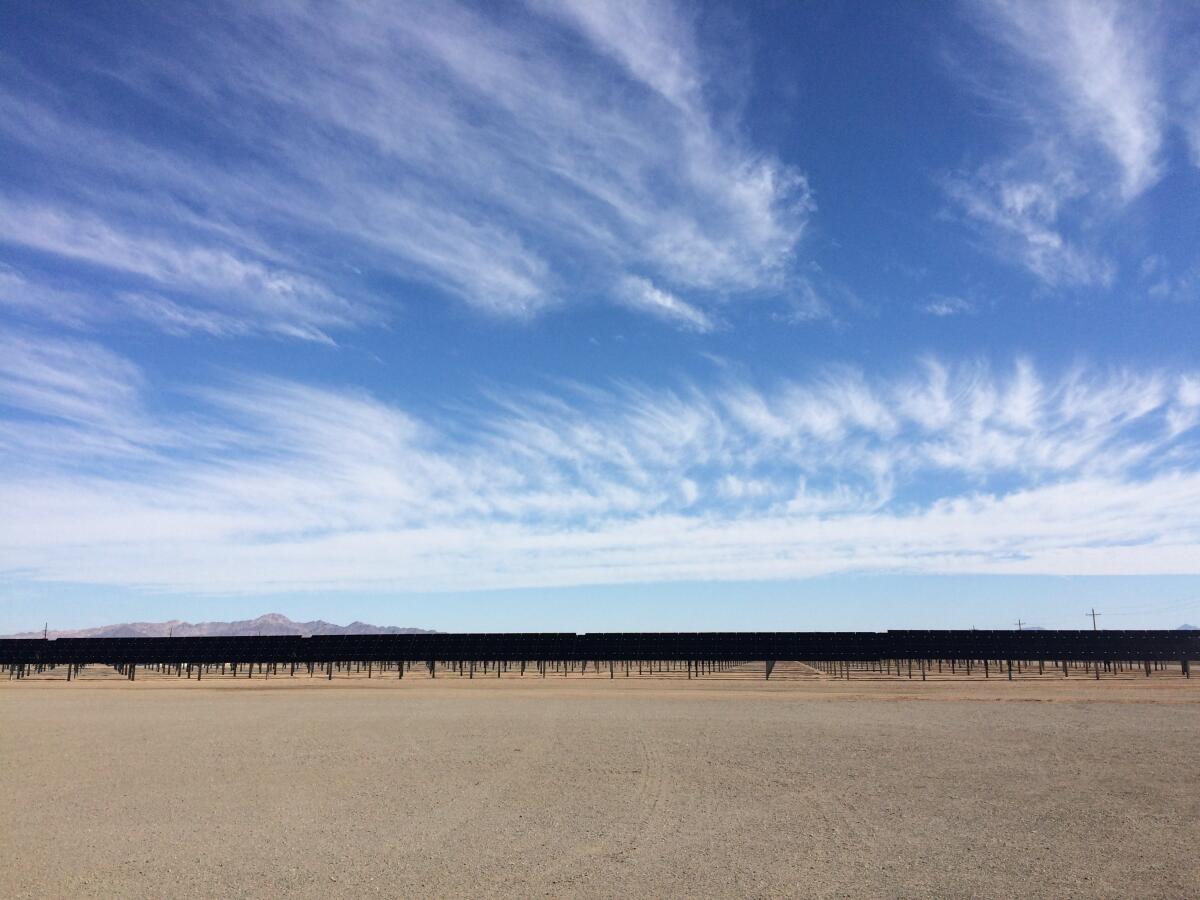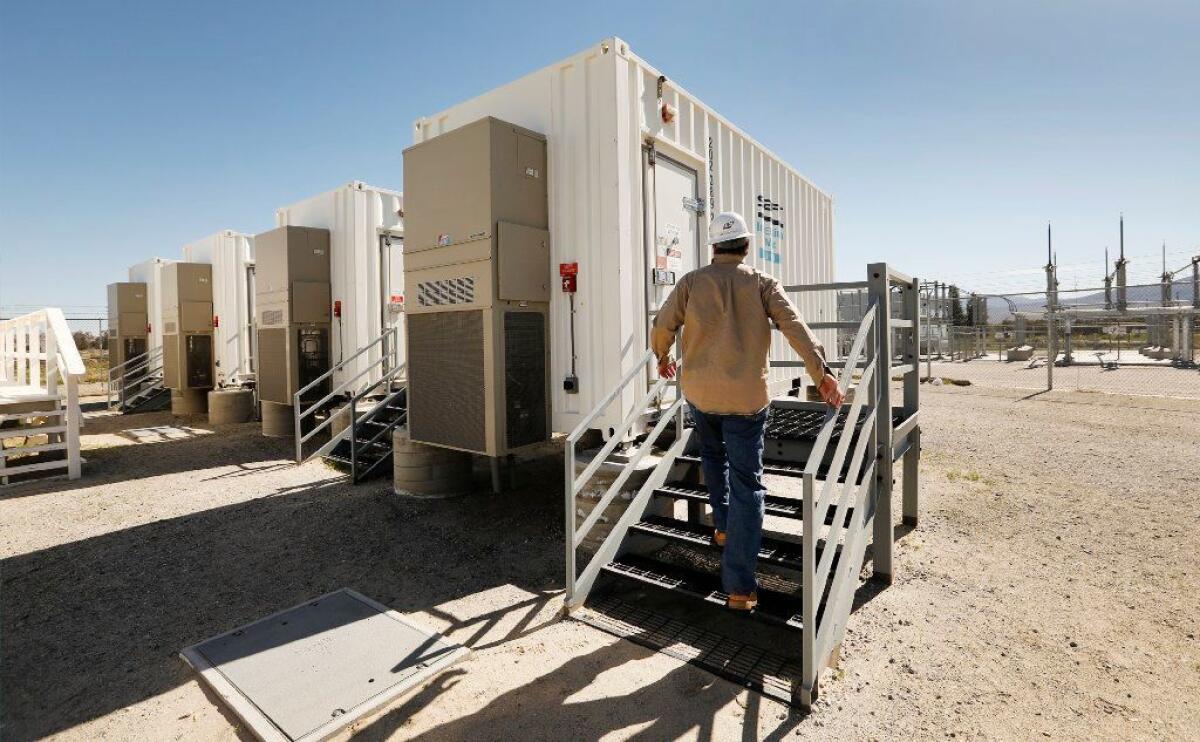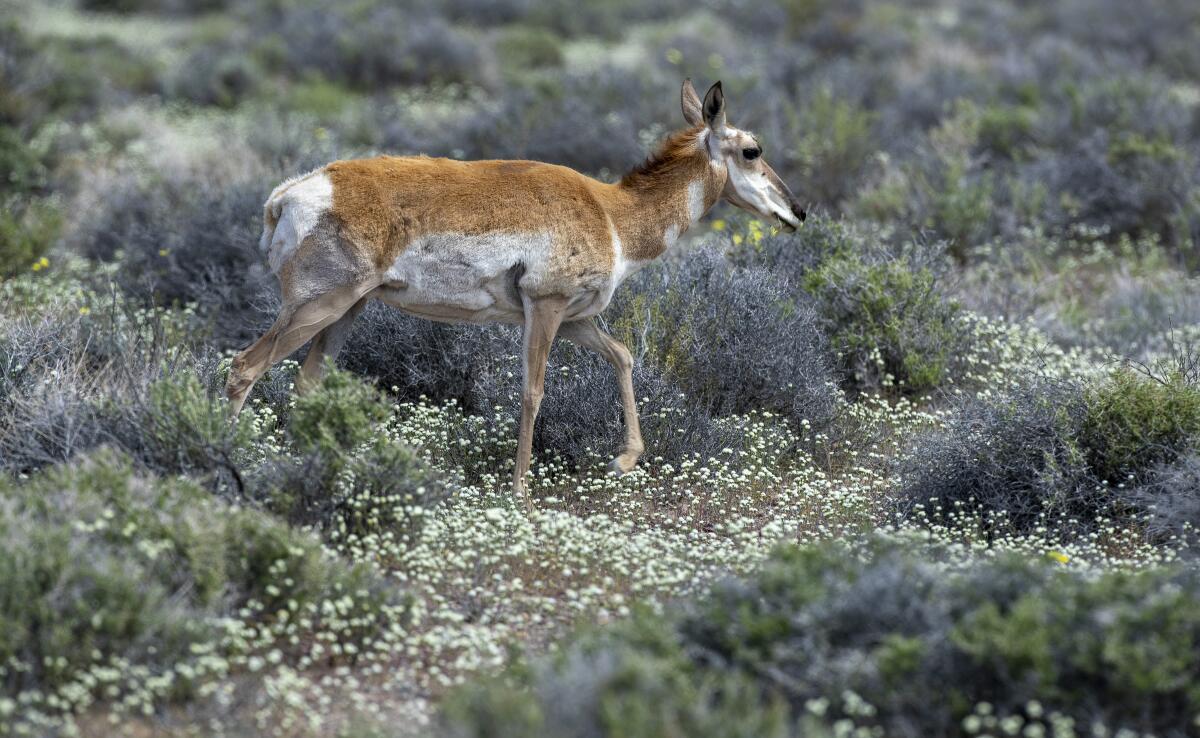Boiling Point: Giant batteries are changing everything for clean energy

Welcome to Boiling Point, a newsletter about climate change, energy and the environment in California and the American West. Iâm Sammy Roth, a reporter for the Los Angeles Times.
Two days after Donald Trump was elected president, I woke up early and drove east from Palm Springs along Interstate 10, stopping just before the California-Arizona state line, about halfway between Los Angeles and Phoenix. The desert was even flatter than normal here. Thousands of acres had been scraped and graded for solar panels, which tilted en masse to face the rising sun, looking like a gleaming black sea against a backdrop of jutting mountains and blue sky streaked with wispy clouds.
Various dignitaries had gathered to commission this massive solar farm, which produces electricity for Southern California Edison. Itâs now being expanded to serve additional utility customers in Los Angeles County, San Francisco and the San Joaquin Valley.
Another big change is coming to the solar facility. Itâs going to get some enormous lithium-ion batteries.
Toward a more sustainable California
Get Boiling Point, our newsletter exploring climate change, energy and the environment, and become part of the conversation â and the solution.
You may occasionally receive promotional content from the Los Angeles Times.
Edison announced this month that itâs buying 770 megawatts of batteries, more than half of which will be installed at this remote outpost near the city of Blythe. The batteries will help Edison replace four gas-burning power plants along the Southern California coast, in part by storing electricity generated by solar panels for times when the sun isnât shining.
For context, 770 megawatts is more energy storage than was installed in the entire United States last year. Itâs enough batteries to meet about 3.5% of all the mid-afternoon electricity demand on Californiaâs main power grid so far this week.

Lithium-ion batteries are no climate change panacea. They typically store only a few hoursâ worth of electricity. But as battery costs fall, experts say the technology can play a significant role in shifting the power grid away from planet-warming fossil fuels.
I called up Pedro Pizarro, president and chief executive of Edisonâs parent company, to ask him a few questions. Here are some highlights from our conversation, condensed and edited for clarity. Scroll down for the rest of this weekâs news.
***
ME: Was it easy or difficult for Edison to find this much cost-effective energy storage on the market?
PIZARRO: It was a very competitive process for the utility. We had lots of interest out there. I expect that five years from now, weâll see an even broader market with even more offerings.
To put it in context, our analysis suggests that to meet its statewide goal of carbon neutrality by 2045, California will need around 30,000 megawatts of storage to balance out about 80,000 megawatts, maybe more, of new renewables. So when you look at it in that context, 770 megawatts is big â itâs one of the largest procurements weâve seen â but itâs just another stepping-stone.
ME: How will these batteries help Southern California Edison transition away from natural gas?
PIZARRO: We do still see a role for natural gas-fired resources for a long time. If you look at the 2045 analysis that we did, we saw 6% of the stateâs electric generation still coming from natural gas. That meant you still had half of todayâs natural gas use. But that gas thatâs being used in 2045, 40% is coming from renewable sources [such as methane from organic waste].
Itâs all a matter of degree. Weâre certainly not in the camp of saying you can somehow magically pull the plug on gas overnight. That would be very destabilizing for the system, it wouldnât be good for the economy. But thereâs a responsible transition that makes sense for the economy, makes sense for greenhouse gas reduction. And certainly adding storage supports that.
ME: What are the shortcomings of todayâs batteries, and what other technologies might fill those gaps?
PIZARRO: There are a lot of different battery chemistries that are being explored now that would have better applicability to different use cases, with better economics in the long run, than the main battery we have today, which is lithium-ion.
Costs have come down a lot, but lithium-ion is still expensive. As you think about going to further scale, for the kinds of volumes weâre talking about, you get into the supply chain for not only lithium, but some of the other rare earth metals that you need as part of the chemistry for the total battery package.
Lithium-ion batteries are typically a four-hour product. We would like to have multi-day, multi-week, even seasonal kind of storage. So thatâs where youâll continue to see research and hopefully development.
***
Hereâs what else is happening this week:
TOP STORIES
Fire season is coming, and coronavirus will make firefighting more difficult. Thatâs the key takeaway from this scary but important story by Joseph Serna, who writes that authorities are worried about wildfire smoke impairing firefightersâ immune systems and making them more vulnerable to COVID-19. Theyâre also worried about the virus spreading at crowded base camps, and about inmates â who make up 43% of Californiaâs firefighting force â not being available as the virus spreads in prisons.
I noted last week that climate change is making it easier for infectious diseases to spread. For everything you ever wanted to know on that topic, read this powerful story by ProPublicaâs Abrahm Lustgarten, who chronicles the many ways in which habitat destruction, biodiversity loss and rising temperatures âhave allowed disease to explode.â While thereâs no evidence right now suggesting that climate change directly caused the COVID-19 pandemic, itâs certainly making this type of outbreak more likely.

Nobody knows why pronghorn antelope have returned to Death Valley. But you can bet that my colleague Louis Sahagun â who specializes in finding fascinating nuggets in the desert â ventured to one of my favorite places on Earth to find out. Read his dispatch from Death Valley National Park, and enjoy the breathtaking pronghorn and wildflower photos by Brian van der Brug.
POWER STRUGGLES
The clean energy sector has lost nearly 600,000 jobs. Thatâs according to a new report from the advocacy group Environmental Entrepreneurs, as I reported here. But there are plenty of proposals being floated for how government might use economic stimulus funds to grow the clean energy workforce and fight climate change. Thatâs not likely to happen at a federal level, at least while Donald Trump is president. But the odds seem good for some kind of stimulus in California. Again, hereâs my story.
The fossil fuel sector isnât doing great, either. Due to the global downturn, San Diego-based Sempra Energy says it will delay a decision on whether to build a liquefied natural gas export terminal on the Gulf Coast, according to the San Diego Union-Tribuneâs Rob Nikolewski. Meanwhile, Great River Energy decided to shutter a massive coal plant in North Dakota and transition to wind energy, as Mike Hughlett reports for the Star Tribune. That oneâs got nothing to do with COVID-19; itâs just economics at work.
It appears Alameda County will allow Tesla to reopen its Bay Area auto factory. The decision follows a turbulent week during which Chief Executive Elon Musk sued the county and slammed its health officer, an infectious disease expert, as âunelected and ignored.â He also threatened to move the companyâs headquarters out of California depending âon how Tesla is treated in the future.â The dispute prompted L.A. Times columnist Michael Hiltzik to ask: âDoes California need Musk more than Musk needs California?â
Consider subscribing to The Times
Your support helps us deliver the news that matters most.
Become a Los Angeles Times subscriber.
THE GREAT OUTDOORS
Southern California trails, parks and beaches are starting to open back up, but please be safe out there. Follow the example of the folks who wore masks and kept their distance at Griffith Park this weekend. And remember youâre supposed to stay close to home and not congregate in groups larger than one household. That means no driving to Sierra Nevada towns to camp or climb â they have precious little medical capacity and are urging tourists to stay away, as Jaclyn Cosgrove and Sarah Parvini report.
Personally, Iâm not sure when Iâll start hiking again. But when I do, I hope to run into the Summit Sippers. Iâd never heard of them until reading this lovely column by my colleague Chris Erskine. The Sippers are three friends who set up makeshift bars in the middle of Los Angeles-area trails and hand out free drinks to hikers. It sounds too good to be true, but Chris insists theyâre not selling or promoting anything â theyâre just looking to offer parched hikers some unexpected refreshment. Iâll drink to that.
If youâre missing the feeling of being in nature, now might be a good time to take up birding. Youâve probably heard all the urban birdsong thatâs no longer drowned out by the drone of cars. If youâre curious which birds are singing those sweet tunes, check out this excellent birding guide from Mary Forgione, which will point you to the apps and info you need to get started.

AROUND THE WEST
Climate change is fueling a megadrought in the West. Thereâs been lots of research showing that global warming has played a big role in sapping the Colorado River, and that rising temperatures will further diminish the regionâs precarious water supplies. Now a new study finds that over the last two decades, climate change âhas turned what would otherwise have been a relatively moderate event into one of the most severe megadroughts since 800 A.D.,â as Ian James reports for the Arizona Republic.
The Midwest also faces climate-fueled drought. Where does the arid West begin, and where does it end? Scientists were surprised to find that the Upper Missouri River Basin was historically dry during the first decade of this century â and that climate change reducing Rocky Mountain snowfall in Montana was partly to blame, as Darryl Fears reports for the Washington Post.
You donât have to worry about âmurder hornets,â despite viral stories about these bugs being seen in Washington state for the first time. More people die from wasp, bee or hornet stings in the United States than from âmurder hornetâ stings in Japan, as Faith E. Pinho reports. Also, Jeanette Marantos notes that the âmurder hornetâ moniker actually comes from a TV show.
What do you want to know?
When you think about Californiaâs climate future, what keeps you up at night, and what gives you hope? What do you want to understand? What should I?
This newsletter is for you. I want to hear your questions, concerns and ideas. Email me or find me on Twitter.
ONE MORE THING
I first met S. David Freeman shortly after joining The Times in 2018. He had flown cross-country and shown up at a Los Angeles Department of Water and Power board meeting to excoriate the agency, which he once led, for its plan to invest billions of dollars in three fossil fueled power plants. Standing under his own power at age 93 and wearing his trademark cowboy hat, Freeman delivered a blunt message to Mayor Eric Garcettiâs appointees: âLet me remind you that you are a big nasty polluter today.â
Freeman died this week after suffering a heart attack. During a long and legendary career, he led four of Americaâs largest public power agencies, advised three presidents, and served as L.A.âs deputy mayor. He was a spirited crusader for clean energy and climate action. To me, he was the perfect source, a font of knowledge and experience who never hesitated to speak his mind.
Hereâs our obituary, by Matthew Ormseth. And here are some tributes that poured in on Twitter, including one from Garcetti.
Iâll be back in your inbox next week. If you enjoyed this newsletter, please consider forwarding it to your friends and colleagues.




